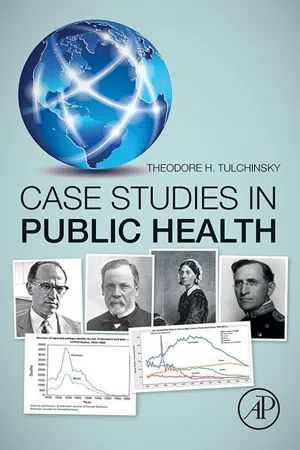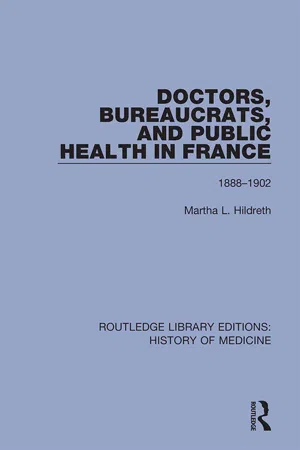History
Louis Pasteur Germ Theory
Louis Pasteur's Germ Theory revolutionized the understanding of infectious diseases by proposing that microorganisms, or germs, are the cause of many diseases. This theory laid the foundation for modern microbiology and led to significant advancements in public health and medicine. Pasteur's work also contributed to the development of vaccines and sterilization techniques, ultimately saving countless lives.
Written by Perlego with AI-assistance
Related key terms
3 Key excerpts on "Louis Pasteur Germ Theory"
- eBook - ePub
- Theodore H. Tulchinsky(Author)
- 2018(Publication Date)
- Academic Press(Publisher)
Pasteur succeeded in producing vaccines through attenuation, or weakening an organism’s strength aging of the organism in the culture media, as for chicken cholera vaccine, or by passing it successively through animals, recovering it, and retransmitting it to other animals. He postulated that if a vaccine can prevent smallpox, then one can be created for all diseases. In collaboration with a physician, he inoculated chickens with chicken cholera germs taken from an old culture. The dispute continued, however, with “germ theorists,” “miasmists,” or “sanitationists” arguing with equal vehemence.When Pasteur published the concept that the very microorganisms that contaminated the liquids also floated in the air, it was met with ridicule and rejected by the medical establishment. Pasteur’s monumental proof of the Germ Theory, over time drastically influenced the way in which public health evolved. He proved the existence of germs and their role in disease causation, confirming previous discoveries and promoting new scientific development in microbiology and immunology.While the Germ versus Miasma issue was debated until the end of the 19th century, the practical application of sanitary reform was promoted by both theories. Increasing attention to sewage, water safety, and removal of waste products by organized municipal activities was adopted in European and North American cities. The Sanitary Revolution proceeded while the debates raged and solid scientific proof of the Germ Theory accumulated, primarily in the 1880s. Fear of cholera stimulated New York City to establish a Board of Health in 1866. In the city of Hamburg, Germany, a Board of Health was established in 1892 only after a cholera epidemic attacked the city, while the neighboring town remained cholera-free because it had established a water-filtration plant.The specific causation of disease (Germ Theory) has been a vital part of the development of public health. The bacteriologic revolution led by the work of Louis Pasteur and his rival Robert Koch provided enormous benefit to medicine and public health. But those who argued that disease is environmental in origin (the Miasma Theory) also contributed to public health because of their recognition of the importance of social or other environmental factors, such as poor sanitation and housing conditions or nutritional status, all of which increase susceptibility to specific agents of disease, or the severity of disease. - eBook - ePub
- James J. Walsh(Author)
- 2012(Publication Date)
- Start Publishing LLC(Publisher)
His attention was next naturally directed to the diseases of animals and human beings. His studies in fermentations and in silkworm diseases had taught him the use of the microscope for such investigations. Splenic fever—known also as anthrax—a disease that attacks most species of domestic animals and may also prove fatal to man, was the first to yield the secret of its origin. The cause proved to be a bacterium—that is, a small, rod-shaped plant. This was but the first of a series of similar discoveries, until now the science of bacteriology has become one of the most important branches of knowledge. Pasteur’s investigations included much more, however, than the mere discovery of the germ of the disease. He showed that a series of diseases which passed under different names in different animals were all due to the same cause. Further, he discovered one of the methods of distributing the disease. When the carcasses of animals that have died from the disease are not buried deeply below the surface of the ground, animals grazing above may become infected with the disease. The germs of the disease can be shown to occur in the grass above the graves. It is carried to the surface in the bodies of earth-worms. This important observation was the first hint of the methods of disease distribution by some living intermediary. Modern medicine has come to understand that these biological distributing agents are far more important than the fabled transmission through the air.Pasteur overturned the notion of spontaneous generation of life. Then his work eradicated the idea of the spontaneous generation of disease. It opened up a new era by showing that the origin of many diseases is not due to changes in the atmosphere nor to some morbid productivity of soil or water under favoring circumstances, but to minute living organisms whose multiplication is encouraged by the conditions that were supposed to produce disease. Finally, came the precious suggestion that living things always convey and distribute disease; man to man, for epidemics travel not with the velocity of the wind but only as fast as the means of communication between distant points; animal to man, as is well known, for many diseases now; and, lastly, insects, worms and the like were also shown to be real carriers of disease. - eBook - ePub
- Martha L. Hildreth(Author)
- 2018(Publication Date)
- Routledge(Publisher)
49In the 1880s, the popular medical journals still expressed considerable scepticism toward germ theory. Physicians continued to confuse contagion theory and miasmatic concepts of disease. 50 In the early 1880s, Dr. A. Bechamp of Lille promoted a theory of “Microzymas” which rivaled Pasteur’s microbe theory. Bechamp’s theory espoused spontaneous generation in a combination of germ and miasma theory. 51 In the 1890s, doctors writing for a popular audience still implicated air temperature and atmosphere as the main causes of cholera and flu. 52 Le Concours gave a great deal of publicity to Koch’s supposed development of an inoculation to treat tuberculosis, and when the technique subsequently proved useless, it became somewhat disenchanted, again, with germ theory. 53As the hygienists began to accept germ theory, they began to revive the once maligned theories of asepsis espoused by Joseph Lister in the 1860s. This was particularly true after the aseptic operation was performed in Germany in 1886. 54 It is difficult to know to what extent doctors in private practice were applying the principles of asepsis in the 1890s. Maurice de Fleury is probably a reliable witness on this issue because he was much admired by Cezilly and wrote generally in praise of the medical profession. 55 However, in 1890, Fleury had some critical comments to make about the inattention which doctors gave to contagion:“Doctors themselves are not what they should be. Dr. Maurice Letulle, speaking of the role of practicians in the face of infectious disease, demonstrates that the doctor himself is doubtless an agent of transmission of illnesses. He cites numerous cases and don’t we all know that the children of doctors themselves are frequently the victims of illnesses carried to them by their fathers?
Learn about this page
Index pages curate the most relevant extracts from our library of academic textbooks. They’ve been created using an in-house natural language model (NLM), each adding context and meaning to key research topics.


